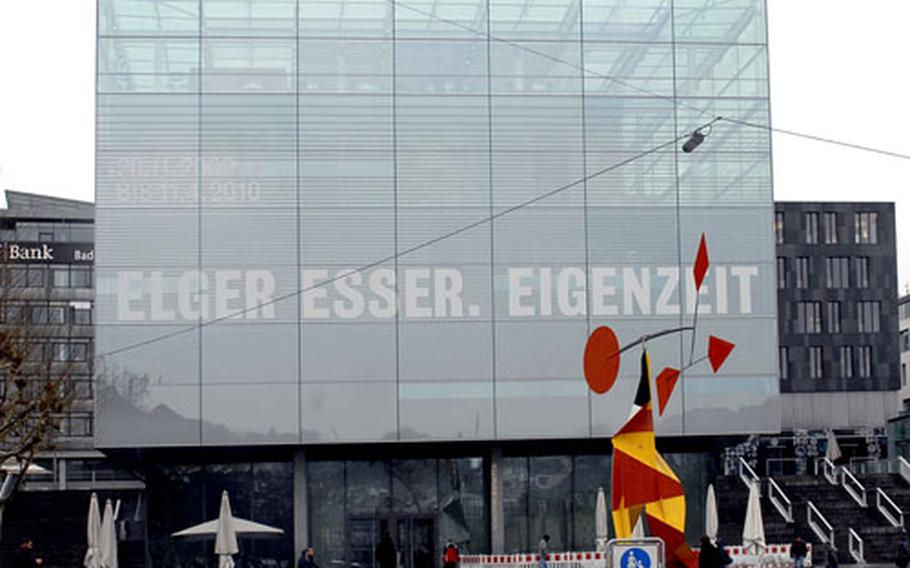
The Kunstmuseum Stuttgart is also known as "the cube." The art museum has several floors of photos, paintings, sculptures and other works. It also is in the city's busy Schlossplatz. (Mark Abramson / S&S)
Nestled among the buildings on the Schlossplatz in Stuttgart, Germany, is a glistening glass cube that is a far cry from the surrounding offices, big-box stores and nearby Starbucks.
The structure houses the Kunstmuseum Stuttgart, the city’s art museum that opened in 2005 with a collection from an existing gallery. The glass cube reflects the buildings around it and advertises temporary exhibits. Out front, a large mobile by American artist Alexander Calder adds a splash of color.
As one enters the cube, the closest attraction is the collection of photos from the Spanish Civil War, of people leisurely lying around in the same time period and children being kids at play. The black-and-white collection is predominantly from 1936 and 1937. But since those photos depict war, there are some bloody photos as well that may not be suited for younger children.
There’s also plenty of white space on the walls that can leave visitors yearning for more as they traverse the glass building’s five floors. A complete tour of the museum takes 90 minutes to two hours.
The lower floors house the permanent exhibits and, on this visit, a temporary display of the works of German artist Elger Esser. Esser’s works have a nautical theme with renderings of boats washed up on shore, shipyards and people along the beach. The exhibit continues until April 11.
The permanent paintings, however, are the real draw for visitors to the cube. Principal among them are works by Otto Dix, an early 20th-century German artist who painted landscapes and World War I figures, such as a German soldier in a gray overcast-like setting with a rifle slung over his shoulder.
As is frequently the case with modern art, it is not always easy to tell what each piece is meant to depict. Amid the paintings is a smattering of sculptures, including one that looks like a large ball of twine. Other works look like multicolored splotches. And one piece, titled “Bugs Bunny, Micky und Donald,” looks like something that my 7-year-old niece could have whipped up with some Crayolas, Play-Doh and glue.
Going from floor to floor is a voyage in itself, with a staircase along the perimeter of the glass cube that gives views of the Schlossplatz from different heights and angles. The entrances to the exhibits are hard to find at first on some of the floors, since the doors are glass panels that open automatically when you get close enough to them.
The fifth floor is a pricey restaurant with a view of the Schlossplatz — whose proximity is another draw for the museum.
The Schlossplatz is a smorgasbord of shops, restaurants and nearby attractions that is easy to get to without paying for parking. The museum is just yards from Stuttgart’s light-rail train.
Know and go ...DIRECTIONS: From Robinson Barracks, go left and follow that road to Gotthilf-Bayh-Strasse/K1910 and then onto K9512, going through one roundabout. Turn left onto Wilhelmstrasse and continue onto König-Karl-Strasse and then B14/ Cannstatter Str. Take a slight right at Konrad-Adenauer-Strasse, and then another slight right at Planie, staying on Planie onto Schlosstrasse. The museum is on the right at Kleiner Schlossplatz 1. The museum also can be reached by taking Bus 42 or 44 to the Schlossplatz and Underground lines U5, U6, U7 and U15 to Schlossplatz as well as S-Bahn transit to Stadtmitte station.
TIMES: The museum is open 10 a.m. to 6 p.m. Tuesday through Sunday, except for Wednesday and Friday, when it is open until 9 p.m. It is closed Mondays. Guided tours without a prior reservation are available 6-7 p.m. Wednesday and Friday and 3-4 p.m. Saturday and Sunday.
COSTS: Admission is 5 euros for adults and 3.50 euros for those qualifying for reductions; admission to the museum and the temporary Elger Esser exhibit is 8 euros, 6.50 euros for those qualifying for reductions. Children 12 and younger are free, and family tickets and group rates are also available. Guided tours are 2.50 euros, 1.50 for the reduced rate.
FOOD: The museum has a bar on the entry level and a restaurant on the top floor. There are restaurants in the Schlossplatz area that range from fast food to Asian and other cuisine.
INFORMATION: The museum’s Web site, www.kunstmuseum-stuttgart.com, is in German and English. Some of the staff members speak English. The museum can be reached by calling 0711-216-2188.
— Mark Abramson